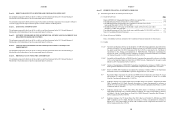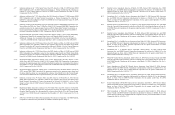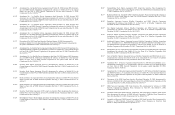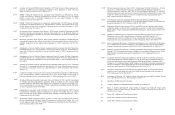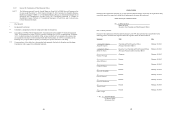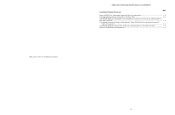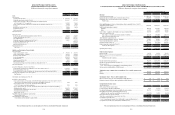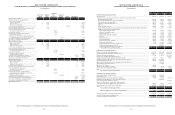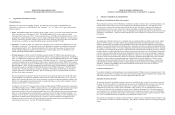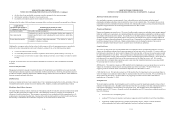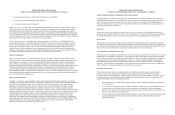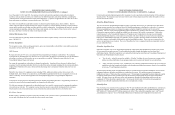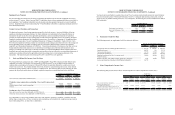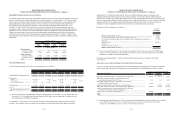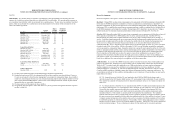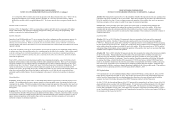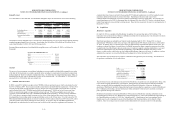Dish Network 2012 Annual Report Download - page 60
Download and view the complete annual report
Please find page 60 of the 2012 Dish Network annual report below. You can navigate through the pages in the report by either clicking on the pages listed below, or by using the keyword search tool below to find specific information within the annual report.
DISH NETWORK CORPORATION
NOTES TO CONSOLIDATED FINANCIAL STATEMENTS - Continued
x the fair value of our marketable investment securities compared to the carrying amount,
x the historical volatility of the price of each security, and
x any market and company specific factors related to each security.
Declines in the fair value of debt and equity investments below cost basis are generally accounted for as follows:
Length of Time
Investment Has Been In a
Continuous Loss Position
Treatment of the Decline in Value
(absent specific factors to the contrary)
Less than six months Generally, considered temporary.
Six to nine months
Evaluated on a case by case basis to determine whether any company or
market-specific factors exist indicating that such decline is other-than-
temporary.
Greater than nine months Generally, considered other-than-temporary. The decline in value is
recorded as a charge to earnings.
Additionally, in situations where the fair value of a debt security is below its carrying amount, we consider the
decline to be other-than-temporary and record a charge to earnings if any of the following factors apply:
x we have the intent to sell the security,
x it is more likely than not that we will be required to sell the security before maturity or recovery, or
x we do not expect to recover the security’s entire amortized cost basis, even if there is no intent to sell the
security.
In general, we use the first in, first out method to determine the cost basis on sales of marketable investment
securities.
Trade Accounts Receivable
Management estimates the amount of required allowances for the potential non-collectability of accounts receivable
based upon past collection experience and consideration of other relevant factors. However, past experience may not
be indicative of future collections and therefore additional charges could be incurred in the future to reflect differences
between estimated and actual collections.
DISH Inventory
Inventory is stated at the lower of cost or market value. Cost is determined using the first-in, first-out method. The cost
of manufactured inventory includes the cost of materials, labor, freight-in, royalties and manufacturing overhead.
Blockbuster Rental Library Inventory
Our rental library inventory consists of movies and video games available for rental by customers and previously rented
movies and video games that are available for sale. Our rental library inventory is carried at cost and includes an
allocation of certain overhead costs. This inventory is amortized over its estimated useful life ranging from six to 24
months down to an estimated residual value. Because of the relatively short useful lives of this inventory and because
this inventory is available for sale to customers at any time, we view these assets as current assets.
F-10
DISH NETWORK CORPORATION
NOTES TO CONSOLIDATED FINANCIAL STATEMENTS - Continued
Blockbuster Merchandise Inventory
Our merchandise inventory consists primarily of new and traded movies and video games and other general
merchandise, including confections, and are stated at the lower of cost or market value. We include in the cost of our
merchandise inventory an allocation of certain overhead costs. Merchandise inventory costs are determined using the
weighted-average method, the use of which approximates the first-in, first-out basis.
Property and Equipment
Property and equipment are stated at cost. The costs of satellites under construction, including certain amounts prepaid
under our satellite service agreements, are capitalized during the construction phase, assuming the eventual successful
launch and in-orbit operation of the satellite. If a satellite were to fail during launch or while in-orbit, the resultant loss
would be charged to expense in the period such loss was incurred. The amount of any such loss would be reduced to
the extent of insurance proceeds estimated to be received, if any. Depreciation is recorded on a straight-line basis over
useful lives ranging from one to 40 years. Repair and maintenance costs are charged to expense when incurred.
Renewals and improvements that add value or extend the asset’s useful life are capitalized.
Long-Lived Assets
We review our long-lived assets and identifiable finite lived intangible assets for impairment whenever events or
changes in circumstances indicate that the carrying amount of an asset may not be recoverable. For assets which are
held and used in operations, the asset would be impaired if the carrying value of the asset (or asset group) exceeded
its undiscounted future net cash flows. Once an impairment is determined, the actual impairment is reported as the
difference between the carrying value and the fair value as estimated using discounted cash flows. Assets which are
to be disposed of are reported at the lower of the carrying amount or fair value less costs to sell. We consider
relevant cash flow, estimated future operating results, trends and other available information in assessing whether
the carrying value of assets are recoverable.
DBS Satellites. We currently evaluate our DBS satellite fleet for impairment as one asset group whenever events or
changes in circumstances indicate that its carrying amount may not be recoverable. We do not believe any
triggering event has occurred which would indicate impairment as of December 31, 2012.
2 GHz Satellite Assets. We currently evaluate our 2 GHz satellite fleet for impairment as one asset group whenever
events or changes in circumstances indicate that its carrying amount may not be recoverable. We are evaluating our
future options for these assets. We do not believe any triggering event has occurred which would indicate
impairment as of December 31, 2012.
Intangible Assets
We do not amortize indefinite lived intangible assets, but test these assets for impairment annually or more often if
indicators of impairment arise. Intangible assets that have finite lives are amortized over their estimated useful lives
and tested for impairment as described above for long-lived assets. Our intangible assets with indefinite lives
primarily consist of FCC licenses. Generally, we have determined that our FCC licenses have indefinite useful lives
due to the following:
x FCC licenses are a non-depleting asset;
x existing FCC licenses are integral to our business segments and will contribute to cash flows indefinitely;
x replacement satellite applications are generally authorized by the FCC subject to certain conditions,
without substantial cost under a stable regulatory, legislative and legal environment;
F-11


